Kaishi: Heart of Paper
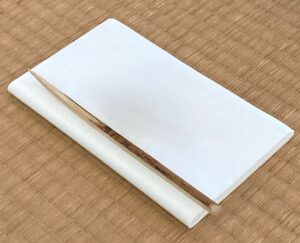
Kai-shi, 懐紙, heart-paper; pack of white papers used by men, with kuro-mo-ji, 黒文字, black-letter-character, wooden pick to eat moist sweets, nama-ga-shi, 生菓子, live-sweet-of.
Men’s kaishi measures 6.8 x 5.8 sun kane-jaku. Women’s kaishi measures 5.8 x 4.8 sun kane-jaku. Kaishi that is expressly made for Chanoyu is the Rikyū konomi, 好, choice, which is a pack of 30 sheets of paper, folded in half. Two-fold, ni-jū, 二重, two-tier, in Buddhism, refers to the two major schools – Mahayana and Theravada.
Paper, wa-shi, 和紙, harmony (Japan)-paper, for kaishi is made from the wood fiber of various plants. The most common choice is kōzo, 楮, Japanese paper mulberry tree, Broussonetia kazinoki x papyrifera. Another familiar fiber is mitsu-mata, 三椏, three-branch, oriental paper bush, Edgeworthia chrysantha. There is also the highly regarded gan-pi, 雁皮, goose-skin, Diplomorpha sikokiana. Fine paper has been made in Japan since the Nara period, having been introduced from Korea. The pick called a kuro-mo-ji, 黒文字, black-letter-character, is cut from the branches of the shrub from which it gets its name. A feature of kuromoji is that the bark continually adheres to the wood. The plant kuro-moj-i, 黒文字, black-letter-character, spice bush, Lindera umbellata var. umbellata, is a fragrant wood that has been a part of Asian natural medicine for millennia.
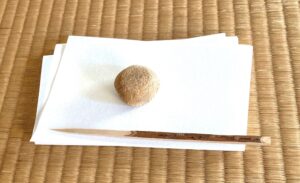
A folded sheet of kaishi with a mochi kashi, and a kuromoji pick, placed on the entire supporting pack of kaishi. The single sheet of kaishi is folded so that the top tier is somewhat to the right. Offerings have the top sheet somewhat to the left.
A sheet of kaishi is used once, it is temporal, whereas the kuromoji pick can be used repeatedly. Given by the host, the kuromoji can be a memento of the event. Japanese paper is made in an abundance of water; however, it is dry when used to eat a sweet or write a poem. The kuromoji pick is made wet so that the food won’t adhere to the stick. Kaishi for Chanoyu should be plain white paper, mu-ji, 無地, no-ground. Designs are distracting.
Each pack of Rikyū kaishi has 30 sheets of paper that are folded in half to create 60 layers. The number 60 is significant in Japanese and Asian cultures, as it the related to 60-year cycle of the Asian zodiac and the five elements. The years, months, days, directions, time, etc. are marked with various signs such as the E-To or Kan-shi, 干支, Stem-branch. It is made up of the Ji-kan, 十干, Ten-celestial stems, which are based on the In and Yō, 陰and陽, Yin and Yang, negative and positive aspects of the Go-gyō, 五行, Five-transitions, physical elements: Earth, Water, Fire, Metal, and Wood. These signs are combined with the Jū-ji-shi, 十二支, Ten-two-branches, the twelve animals of the Asian zodiac. Ne, Rat, Ushi, Ox, Tora, Tiger, U, Hare, Tatsu, Dragon, Mi, Snake, Uma, Horse, Hitsuji, Ram, Saru, Monkey, Tori, Chicken, Inu, Dog, I, Wild Boar.
A person’s age is also identified with the E-To. The year and the day that one is born is marked by the sign of the Asian zodiac and one of the 10 stems. For example the first of the 60 signs is Ki-no-e Ne, 甲子, Wood-’s-elder Rat. The next time that sign occurs again is 60 years later. In a sense one is reborn, and the event is called a kan-reki, 還暦, return-calendar. This system of calculation has existed in Asia since ancient times.
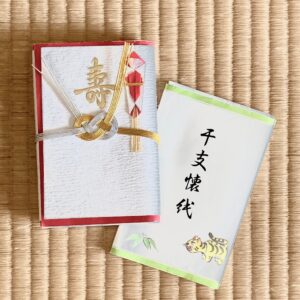
An old custom in Japan is when receiving a gift, in appreciation, one gives a present called o-kaeshi, お返し, hon.-return. The return gift is quite often o-kaishi, お懐紙, hon.-heart-paper, which is wordplay on okashi. The kaishi of 60 layers of paper is a metaphor for longevity, kotobuki, 寿, as inscribed on the wrapper. Kaishi is made in a myriad of styles and sizes and often bears a design of the Asian zodiac animal of that year. The kaishi wrapper may be plain or extravagantly decorated.
When the kaishi and kuromoji are used together, it is to enjoy a moist nama–ga–shi, 生菓子, live-sweet-of. The sweet is eaten before drinking the tea; ma-tcha, 抹茶, powered-tea, which is green, because it, too, is relatively alive. The sweet is a solid, and the tea is a liquid, and these are aspects of Yō and In, 陽and 陰, positive and negative.
The Kanji ka, 菓, for kashi, fruit, cakes, candy, a sweet, is composed of the crown radical kusa, 艹, and ka, 果, fruit, reward, carry out, achieve, complete, end, finish, succeed, fruit, and with the meaning of something produced from a tree. More relevant, is that ka, 果, in Buddhism means ‘enlightenment’, as the fruits of one’s Buddhist practice, which can be referred to as phala, an attained state. Phala has multiple meanings and translations, and can be related to the philosophy of following the Buddhist eight-fold path or it may carry deeper meaning with regards to the results or outcomes of one’s actions.
There could be deeper meaning in coded messages and means of identification. Such as writing the number Kanji jū, 十, and another person writing jū 十, alongside it, would signal acknowledgement of a secret union associated with 20th verse of the Dhammapada, indicating following the eight-fold path of the Buddha.
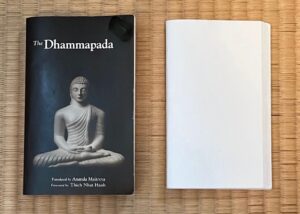
The Dhammapada is a collection Buddha’s teaching in verse form, and to be memorized and chanted. Chapter 20, which describes the Eight-fold Path, and is perhaps the most widely known and read Buddhist teaching. In Japanese, Dhammapada is Ho-kku-kyō, 法句経, Law-verse-sutra, in Pali is translated as Phrases of the Dharma. It is composed of 26 Chapters.
In the Dhammapada verse 70, which is part of the ‘Fools’ chapter, the text emphasizes the importance of understanding the nature of food and the pursuit of wisdom over mere physical austerity, like starving oneself, and mentions that such austerity isn’t a substitute for true enlightenment. This presents proof because in more formal Tea presentations, 3, 5, and 7 kinds of sweets are offered to the guests. Should the guest eat all of them, or are the guests given a choice. Often in modern times, the omogashi is overly large. However, a salad of seven kinds of fruits is not deemed over-indulgent.
The Ni-jū Bon-no, 二十煩悩, Twenty Compulsion-trouble, earthly desires, are in the Buddhist Yogacara school: in Japan the Ho-ssō-shū, 法相宗, Law-mutual-sect. The word Yogacara in Japanese is Yui-shiki, 唯識, Only-consciousness.
There are twenty other delusions in addition to the six fundamental delusions called Kleshas, which are outlined below. The nijū bonnō are classified into ten minor delusions – greed, anger, resentment, distress, deception, flattery, hatred, harm, jealousy, stinginess; two medium delusions – shamelessness and remorselessness; and eight major delusions – distrust, laziness, neglect, sulkiness, ignorance, forgetfulness, false knowledge, and scattering, These delusions are thought to arise as a result of the influence of fundamental earthly desires.
The six fundamental delusions called Kleshas in Sanskrit are called in Japanese the Dai-roku-waku, 六大惑, Six-great-delusions; waku, 惑, delusion, in. The six major delusions are greed, anger, delusion, arrogance, doubt, and wrong views, Analogies taken to an extreme, the six waku may be represented by the kuromoji pick, that is 6 sun kane-jaku long. Other major groups of six are the Roku-dai, 六大, Six-great; which are the Go-rin, 五輪, Five-rings, principles, of Earth, 地, Water, 水, Fire, 火, Wind, 風, Void, 空, plus Consciousness, shiki, 識. A more likely equivalent for the kuromoji pick are the Ro-kkon, 六根, Six-roots: eye, ear, nose, tongue, body, heart (mind).

A pack of kaishi is made of 30 sheets of paper that folded in half, creating a triangle. This is a manifestation of one thing becoming two things. The front or shō-men, 正面, correct-face, of an object that has three prominent features, such as a kō-ro, 香炉, incense-hearth, with three feet, a triangle, one foot is shōmen. When using one’s kaishi, the fold is directed toward the user, so that the fold is the ‘one’, the shōmen. The ceramic incense burner is a kiki gō-ro, 聞香炉, listen incense-hearth, with three feet; H. 2.3 sun kane-jaku, made by Makoto Yabe, 誠矢部, Truth Arrow-guild, Boxford, Mass. Cornered objects manifest the penetrative aspect of Yō, 陽, Yang, and round objects manifest the receptive aspect of In, 陰, Yin.
Paper and the wooden kuromoji are made of wood, and there are certain fragrant woods, that are treated very differently, and are called kō-boku, 香木, fragrant-wood. A fragrant wood incense that is frequently used is kyara, 伽羅, aloes wood, Taxus cuspidata var. nana, is heated over a piece of burning charcoal in a kōro that is ‘listened to’, and passed from person to person. In the Tearoom, such a kōro is part of incense appreciation in the presentation of kō-bon, 香盆, incense-tray. The tiny piece of incense wood is held in a small folder made of kaishi. The first of the three essential offerings is incense: kō ge tō, 香華灯, incense flower lamplight.
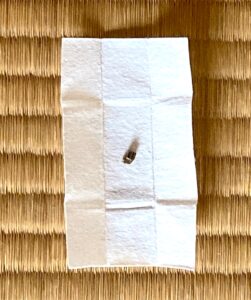
A small piece of kō-boku, 香木, fragrant-wood, on a folder kō-tsutsumi, 高包, incense-wrapper, made from a sheet of kaishi; L. 3 sun kane-jaku. The folder is composed of 9 ‘squares’, which may evoke the Buddhist Kon-gō-kai Man-da-ra, 金剛界曼荼羅, Gold-strength-world Wide-weed-spread.
This pattern of a square composed of nine squares is similar to the arrangement of tatami in Rikyū’s yo-jō-han, 四畳半, four-mat-half, tearoom.It is curious that when taking sweets from a serving tray or bowl, the kaishi is placed on the floor. After putting the sweet on the kaishi, the kaishi is held approximately in front of the stomach, where the sweet is cut with the kuromoji, and eaten.
The physical sweet, when eaten, is destined for the stomach. The meal accompanying Tea is called kai-seki, 懐石, heart-stone, after the Buddhist custom of heating a stone, wrapping it in a cloth and placing in the garment near the stomach. The Tea meal should be enough to stave off hunger. The okashi following the meal is served as a way to prepare for appreciating the taste of the tea.
Kaishi has many aspects that can be used in many ways. In Chanoyu, perhaps the most relevant aspect is its name, kai-shi, 懐紙, heart-paper, because the pack of kaishi is kept in the front folding of the kimono, near the heart. This is not exactly true, as men keep the kaishi in their kimono in front of the stomach above the obi, whereas women keep the kaishi close to the sternum due to the location of the obi. Kaishi is kept along with a fuku-sa, 帛紗, cloth-gauze, cloth of purification, and a ko-buku-sa, 古帛紗, old-cloth-gauze, to protect the hand from the heat of the chawan and to honor a displayed object. The used sheet of kaishi is often used to wipe the rim of the chawan after drinking.
For further study, see also: Kaishi and Kuromoji and Kami Kamashiki and Kamasue

